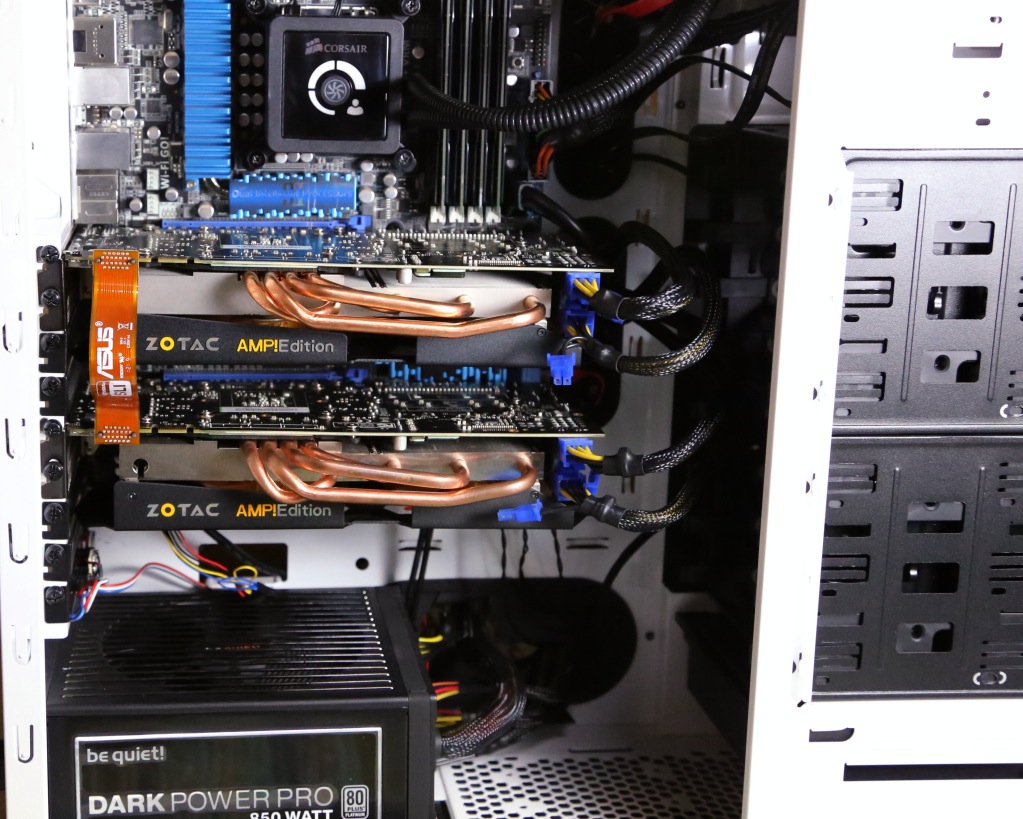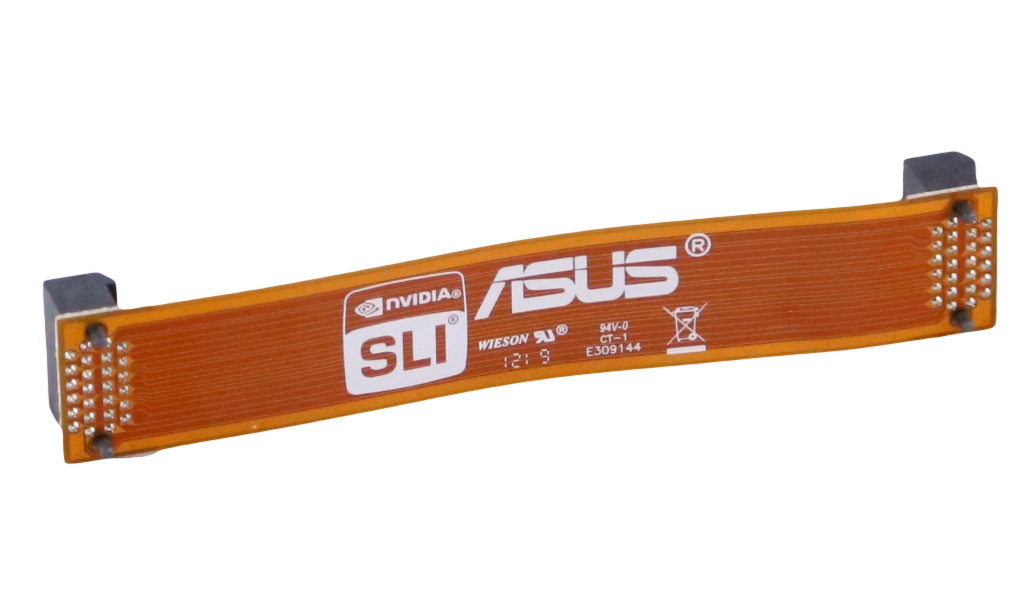WHAT DOES SLI OR CROSSFIRE MEAN?
If you are a frequent flyer of Essentially Tech Media Corp Airlines, then you will know that we frequently test solid state drives in RAID configurations. Similar to RAID, SLI and Crossfire, powered by NVIDIA and AMD respectively, are a way of essentially doubling your systems graphics performance by adding another card to your rig. There is one main constituent though, the GPU in both cards need to be identical, both manufacturer and model. Meaning if you are running a NVIDIA GeForce 780 and another 780, then you are fine. You can even mix sub-brands, for example Zotac GeForce GTX 680 with a MSI GeForce GTX 680. You can not, however, mix manufactures. Putting in a AMD Radeon R9 295X2 with a NVIDIA GeForce GTX TITAN Z would just not work, two completely different manufactures (even though if it were possible that would be an insane setup!).
With SLI and Crossfire, you simply plug your graphics cards into your PCI Express port. Then with the help of a simple connector, or bridge, that should have come with your motherboard, you connect the two cards together. You may even note that your motherboard came with two other bridges, depending on your motherboard: a three-way and a four-way SLI or Crossfire bridge. This would allow you to connect three of four graphics cards together simultaneously and achieve, theoretically, three to four times the graphics output. Note the keyword there was theoretically, as this would occur in a perfect scenario, with all the proper hardware and software running ideally.
The thought process of determining whether you want a SLI or Crossfire configuration starts way at the beginning of your build. Why? You need other hardware that will play a significant role in achieving the desired performance from your graphics card. First off, take a look at your current motherboard. Prior to doing this test, our test system was running an ASUS P8H77-I Mini ITX motherboard, there is no way to achieve a SLI or Crossfire configuration with this board because there is only one PCI Express port on the board. Instead we needed to upgrade to the ASUS P8Z77-V Premium motherboard, which now gives us the opportunity to run up to four graphics cards together.
The other thing we needed to keep in mind was our power supply. Graphics card can draw a significant amount of power while in use, and this can fluctuate based upon the necessary power requirements of different cards. Typically, you will need at least a 850 watt power supply, minimum, to achieve a 2 way SLI configuration, and of course the more cards you add to that configuration, the more power you will need. For us, we again needed to upgrade, but this time is wasn’t a significant jump. Rather than increasing the amount of output, we went for the over clocking option of the be quiet! Dark Power Pro. The over clocking option of the power supply is ridiculously easy, turn off your system, flip a switch, turn your system back on. At no point in time do you actually see anything changing. be quiet! best describes the function of the over clocking key as it “allows switchover between quadruple independent +12V rail mode and high-performance single-rail operation”. This makes it an easy choice for us with today’s SLI configuration test.
Finally, you need to make a small change in your operating system to essentially turn on SLI or Crossfire. Since we are testing a NVIDIA product today, let’s showcase the NVIDIA Control Panel. Head on into Control Panel and open up NVIDIA Control Panel. From here you have your navigation tree on the left side, select Configure SLI, Surround and PhysX. Once inside, take a look at the main aspect of the screen and notice that that you can “Maximize 3D Performance”. Apply your settings, your screen will flash and you will be living life comfortably on a multi-GPU setup.
ARE THERE OTHER COMPONENTS I SHOULD LOOK FOR?
When doing your research for your first, or next graphics card, there are a couple of other components that you can keep an eye out for. While not overly imperative, these are more of a necessity when looking to over clock your graphics card and your personal preference.
If you are looking to do some over clocking, a little bit of research goes a long way … seriously! One of the main aspects of over clocking is the power requirement of the graphics card, and one of the components that may hinder the performance of the graphics card is the voltage regulator module. Basically, the voltage regulator module (VRM) serves as a power supply for the graphics card. If you do some research and find out that VRM is known for being under-sized, then your card could be inhibited from handling the high current required of it. Your best bet when you are reading reviews on graphics cards is to watch for commonalities. If you research a graphics card and it over heats easily when over clocked, it could be due to the VRM.
What else should you keep an eye for? While it may sound like a simple point, it is definitely worth mentioning the input and output panel. Imagine this … you place your order, patiently wait until the delivery guy throws it on your doorstep, get it inside, rip the packaging off, install the card the card in the PCI slot and go to plug your monitor in to find … only mini display ports. Now you’ve got to head out to the store or order an adapter, or a different monitor depending on how much money you want to spend. It’s easy to forget about, but well worth knowing what input and output ports you are going to have on your shiny new graphics card. The most common ports to find today are DVI-I, DVI-D, HDMI and Display Port.
WHAT IS PHYSX? WAIT … WHERE DID YOU LEARN TO SPELL?!
Have you ever played a game where you have looked at the objects and wondered why they move that way? Looked at leaves falling off of a tree and thought they fell differently than they would when you look out your window? That is the physics of the game. To make the game more realistic NVIDIA developed a real-time engine that emulates realistic physics in-game that you would find in real life. Thus bring 3D gaming to a whole new level. As we pointed out in enabling a SLI configuration, you can also adjust which piece of hardware will control the PhysX of the game. Prior to this, CPU’s were the main controller of physics within a game, but now newer cards are coming with a PhysX controller built-in so that your graphics card can control more, leaving your precious CPU to focus on its primary functions. In the NVIDIA Control Panel you can select which processing unit will control the PhysX in your system, but usually it is best to keep it with your graphics card. Take a look at the video below for a comparison between enabled and disabled NVIDIA PhysX.
 Technology X Tomorrow's Technology Today!
Technology X Tomorrow's Technology Today!



Helpful
very helpful
Good article. I used it in one of my college papers
That is perhaps one of the best compliments to this site; thank you.
Now I feel like a huge Geek whenever I explain this stuff to my friends… this is awesome.
Will the next gen card be called Radeon R9 490?
We wouldn’t be able to tell you even if we knew, but most likely.
I was just going the fact the previous cards were 290 and 390 I figured the next logical choice was 490. unless Titan is the name of all cards from now on
if other parts of the site are as good as this article then I’ll have to add this site to my Computer technology bookmark folder.
Care to elaborate? We are always looking for suggestions.
– this is something new. Actually, processors have built-in graphics. Besides, why didn’t you mention the AMD A6/8/10 processors, that are not on par with Intels considering their CPU performance, but if we compare the graphics power, this is where Intel is still far behind even with its Intel 4000.
Besides, look for prices: https://hardware.nl/catalogsearch/result/index/?lang=en_US&manufacturer=AMD&q=AMD+A10
So, if you are not going to play video games, then forget about an additional power-hungry stuff. Such AMD processor will handle even some games. Other than this remark, the article is pretty good to me.
Valid point. APU’s are a great option if your budget doesn’t let you go all out and get a dedicated card.
Take a look at our review of the A8 – AMD A10 7870K CPU Review – Welcoming Competition! or even the A10 – AMD A8 7650K APU Review – The Little APU That Could! … Both show that these are excellent graphics options, which don’t require integrated graphics.
Apu’s are the future eventually discrete gpu’s will become obsolete. AMD made a big step in the right direction with the development of the apu and HSA.
best content for noobie
now i feel like a graphics god XD